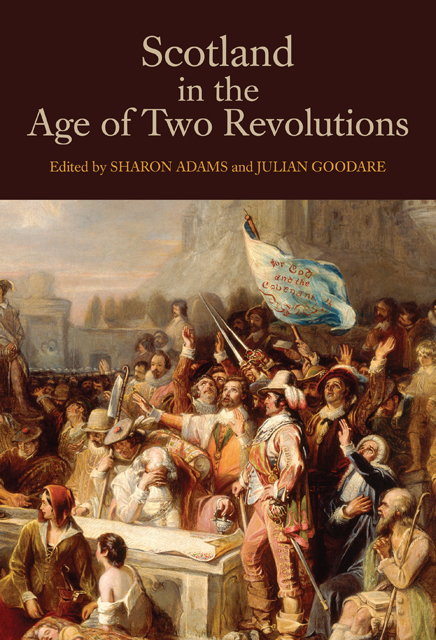Book contents
- Frontmatter
- Dedication
- Contents
- Figures and Tables
- List of Contributors
- Preface
- List of Abbreviations
- 1 Scotland and its Seventeenth-Century Revolutions
- 2 The Middle Shires Divided: Tensions at the Heart of Anglo-Scottish Union
- 3 The Western Highlands and Isles and Central Government, 1616–1645
- 4 The Scottish Bishops in Government, 1625–1638
- 5 The Scottish Revolution
- 6 In Search of the Scottish Republic
- 7 Highland Lawlessness and the Cromwellian Regime
- 8 The Worcester Veterans and the Restoration Regime in Scotland
- 9 The Political Thought of the Restoration Covenanters
- 10 Scottish State Oaths and the Revolution of 1688–1690
- 11 The Tribulations of Everyday Government in Williamite Scotland
- 12 The Company of Scotland and Scottish Politics, 1696–1701
- Chronology of Seventeenth-Century Scotland
- Further Reading
- Index
- Studies in Early Modern Cultural, Political and Social History
9 - The Political Thought of the Restoration Covenanters
Published online by Cambridge University Press: 28 February 2023
- Frontmatter
- Dedication
- Contents
- Figures and Tables
- List of Contributors
- Preface
- List of Abbreviations
- 1 Scotland and its Seventeenth-Century Revolutions
- 2 The Middle Shires Divided: Tensions at the Heart of Anglo-Scottish Union
- 3 The Western Highlands and Isles and Central Government, 1616–1645
- 4 The Scottish Bishops in Government, 1625–1638
- 5 The Scottish Revolution
- 6 In Search of the Scottish Republic
- 7 Highland Lawlessness and the Cromwellian Regime
- 8 The Worcester Veterans and the Restoration Regime in Scotland
- 9 The Political Thought of the Restoration Covenanters
- 10 Scottish State Oaths and the Revolution of 1688–1690
- 11 The Tribulations of Everyday Government in Williamite Scotland
- 12 The Company of Scotland and Scottish Politics, 1696–1701
- Chronology of Seventeenth-Century Scotland
- Further Reading
- Index
- Studies in Early Modern Cultural, Political and Social History
Summary
The covenanting struggle of the Restoration period, between 1660 and 1688, was very different from the movement that had sought from 1638 to resist the episcopal innovations and absolutist ambitions of Charles I and to seek the extension of presbyterianism in England and Ireland as well as Scotland. The National Covenant represented Scotland as a presbyterian nation, and in the 1640s, through military intervention in both England and Ireland, Scotland became a major player in the political and religious tumults of the three kingdoms. From this time until 1660, the established church of Scotland remained presbyterian, despite Scotland’s changing fortunes in victory and defeat, military occupation by Cromwell in the 1650s, and the splintering of the covenanting movement itself. However, by 1662 Scottish presbyterianism found itself in an embattled position, as the government of Charles II established an episcopal church and was determined to suppress dissent. Covenanting was no longer an official national movement.
I
During the Restoration period the Covenanters consisted of a small but vocal minority, concentrated particularly in the south-west of Scotland, and determined to testify against the evils of the church and state while remaining true to their presbyterian values. In the years from 1660 to 1688 their dissent escalated from conventicling to armed conventicling, to rebellion and renunciation of royal authority, all in the face of judicial and military repression. Covenanting resistance extended to assassination attempts against their most hated opponent, Archbishop James Sharp, a man who had travelled to the Low Countries to treat with Charles II on behalf of presbyterianism before the Restoration, only to be raised to Scotland’s highest episcopal office afterwards. Sharp survived an assassination attempt in 1668, but a band of Covenanters caught up with him in 1679, and his killing sparked the rebellion that culminated at Bothwell Bridge. At this juncture, the Covenanters splintered under the weight of persecution, of policies of indulgence designed to split the movement, and of internal theological divisions and disagreements over aims and tactics. The late covenanting movement was one in which unwillingness to compromise was cultivated as a fundamental virtue.
The earlier Covenanters, with their national and supra-national concerns, have received considerably more scholarly attention than the Covenanters of the Restoration period.
- Type
- Chapter
- Information
- Scotland in the Age of Two Revolutions , pp. 155 - 172Publisher: Boydell & BrewerPrint publication year: 2014
- 1
- Cited by



